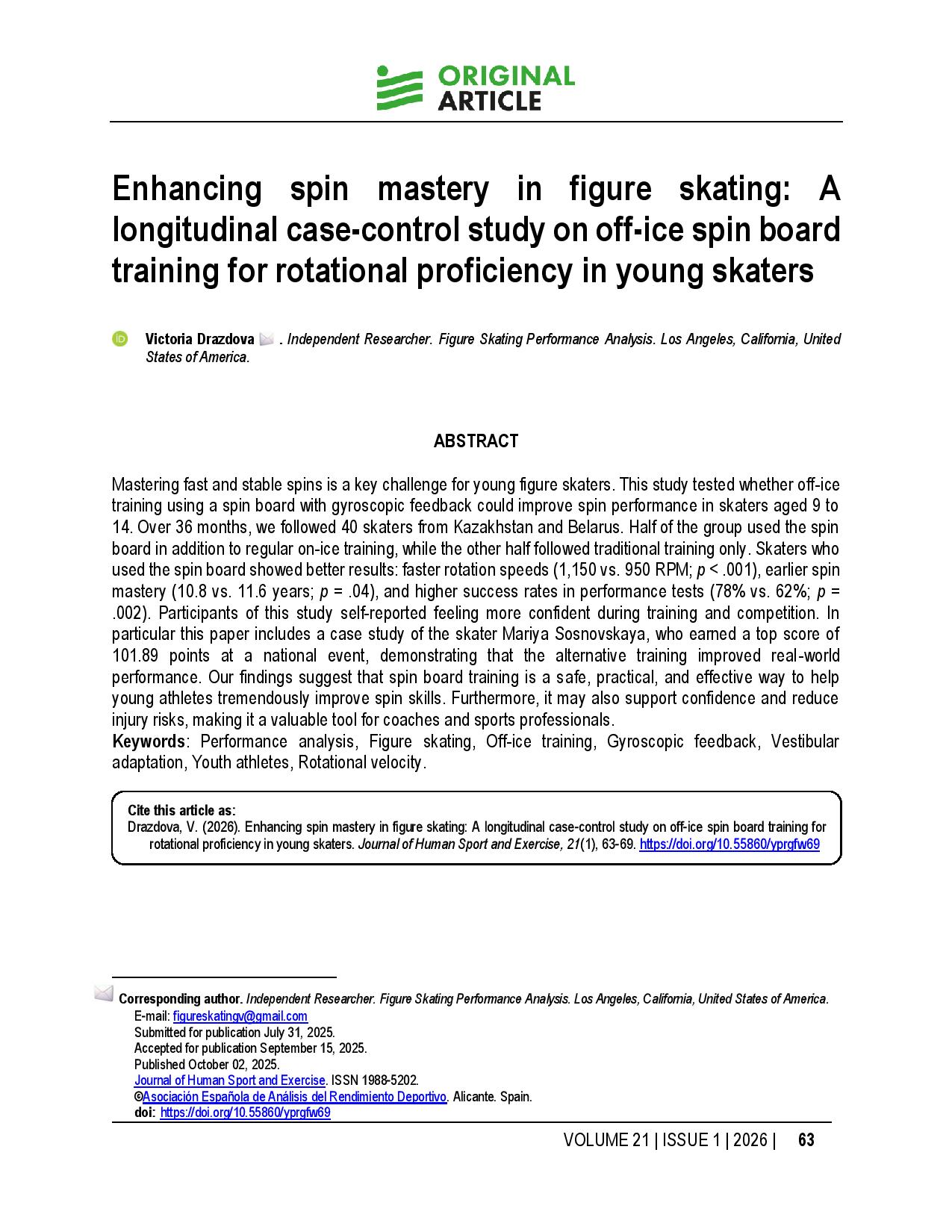Enhancing spin mastery in figure skating A longitudinal case-control study on off-ice spin board training for rotational proficiency in young skaters
Main Article Content
Abstract
Mastering fast and stable spins is a key challenge for young figure skaters. This study tested whether off-ice training using a spin board with gyroscopic feedback could improve spin performance in skaters aged 9 to 14. Over 36 months, we followed 40 skaters from Kazakhstan and Belarus. Half of the group used the spin board in addition to regular on-ice training, while the other half followed traditional training only. Skaters who used the spin board showed better results: faster rotation speeds (1,150 vs. 950 RPM; p < .001), earlier spin mastery (10.8 vs. 11.6 years; p = .04), and higher success rates in performance tests (78% vs. 62%; p = .002). Participants of this study self-reported feeling more confident during training and competition. In particular this paper includes a case study of the skater Mariya Sosnovskaya, who earned a top score of 101.89 points at a national event, demonstrating that the alternative training improved real-world performance. Our findings suggest that spin board training is a safe, practical, and effective way to help young athletes tremendously improve spin skills. Furthermore, it may also support confidence and reduce injury risks, making it a valuable tool for coaches and sports professionals.
Downloads
Article Details
Section

This work is licensed under a Creative Commons Attribution-NonCommercial-ShareAlike 4.0 International License.
Each author warrants that his or her submission to the Work is original and that he or she has full power to enter into this agreement. Neither this Work nor a similar work has been published elsewhere in any language nor shall be submitted for publication elsewhere while under consideration by Journal of Human Sport and Exercise (JHSE). Each author also accepts that the JHSE will not be held legally responsible for any claims of compensation.
Authors wishing to include figures or text passages that have already been published elsewhere are required to obtain permission from the copyright holder(s) and to include evidence that such permission has been granted when submitting their papers. Any material received without such evidence will be assumed to originate from the authors.
Please include at the end of the acknowledgements a declaration that the experiments comply with the current laws of the country in which they were performed. The editors reserve the right to reject manuscripts that do not comply with the abovementioned requirements. The author(s) will be held responsible for false statements or failure to fulfill the above-mentioned requirements.
This title is licensed under a Attribution-NonCommercial-ShareAlike 4.0 International (CC BY-NC-SA 4.0).
You are free to:
Share — copy and redistribute the material in any medium or format.
Adapt — remix, transform, and build upon the material.
The licensor cannot revoke these freedoms as long as you follow the license terms.
Under the following terms:
-
Attribution — You must give appropriate credit, provide a link to the license, and indicate if changes were made. You may do so in any reasonable manner, but not in any way that suggests the licensor endorses you or your use.
-
NonCommercial — You may not use the material for commercial purposes.
-
ShareAlike — If you remix, transform, or build upon the material, you must distribute your contributions under the same license as the original.
- No additional restrictions — You may not apply legal terms or technological measures that legally restrict others from doing anything the license permits.
Notices:
- You do not have to comply with the license for elements of the material in the public domain or where your use is permitted by an applicable exception or limitation.
- No warranties are given. The license may not give you all of the permissions necessary for your intended use. For example, other rights such as publicity, privacy, or moral rights may limit how you use the material.
How to Cite
References
Braun, V., & Clarke, V. (2006). Using thematic analysis in psychology. Qualitative Research in Psychology, 3(2), 77-101. https://doi.org/10.1191/1478088706qp063oa
Brown, J., Smith, L., & Lee, K. (2020). Training adaptations in youth figure skating: Biomechanics and injury risk. Journal of Sports Sciences, 38(10), 1150-1158.
Creswell, J. W., & Plano Clark, V. L. (2011). Designing and conducting mixed methods research (2nd ed.). Sage Publications.
Fortin, J. D., & Roberts, D. (2003). Competitive figure skating injuries. Pain Physician, 6(3), 313-318. https://doi.org/10.36076/ppj.2003/6/313
International Skating Union. (2024). Competition protocols and athlete results database. Retrieved from [Accessed 2025, 22 September]: https://www.isu.org
King, D. L., Johnson, R., & Peters, M. (2005). Angular momentum in figure skating spins. Medicine & Science in Sports & Exercise, 37(1), 111-118.
Knoll, K., & Hildebrand, J. (2000). Mechanics of rotational movements in figure skating. Journal of Applied Biomechanics, 16(4), 413-427.
Lee, M., & Kim, J. (2021). Biomechanical analysis of spins among junior skaters. Sports Biomechanics, 20(3), 355-370.
Nakamura, H., & Petrov, I. (2022). Wearable sensors in figure skating: Enhancing rotational skill acquisition. Sports Engineering, 25(1), 1-12.
Sands, W. A., McNeal, J. R., & Stone, M. H. (2012). High-performance training in prepubescent athletes: Considerations and risks. Strength & Conditioning Journal, 34(3), 24-33.
Smith, L. A., & Davies, R. J. (2010). Off-ice applications in rotational skill acquisition. Journal of Sports Technology and Training, 5(2), 118-127.
Toth, M., & Mikhaylova, E. (2023). Injury risk in youth figure skating spins: A longitudinal perspective. Sports Medicine International Open, 7(1), E35-E41.
Vickers, R. J., & Hayes, M. (2021). Vestibular training in adolescent acrobatic athletes. International Journal of Athletic Performance and Conditioning, 14(2), 211-223.
Zhang, L., Chen, Y., & Wang, Q. (2022). Real-time motion tracking in sports skill training. Sensors, 22(10), 3712. https://doi.org/10.3390/s22103712




